Pessimism and Optimism
Tagged:Beauty
/
COVID
/
Politics
/
Sadness
/
SomebodyAskedMe
Somebody asked me why I’m always so dour. Well, times are hard: pandemic waves, disinformation & death, potential nuclear war over Ukraine, the rise of the fascist right, climate change not only unchecked but furiously denied, and so on. So let’s take some inventory of our problems… and maybe a few points that (may) cause hope for the future.
The Bad News: 6 Reasons to Despair
Fair question: why am I so dour these days? Lifelong clinical depression and becoming an old man probably have something to do with it. But… so does the state of the external world.
To wit, 6 reasons chosen ad libitum from recent news (actually, from my open browser tabs, if you want to know my sources):
Reason 1: The collapse of… everything?… into fascism
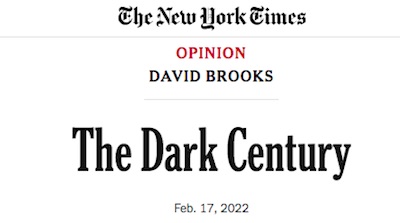 If we’re going to inventory reasons for despair, why not start with a conservative
columnist? Conservatives are, after all, the cause of most of my despair. As I’ve
mentioned a couple times now, I have relatively little patience with
David Brooks in general. He’s
a bit too willing to forgive Republican madness in the name of
St Edmund Burke, way too willing to perpetrate
deeply misleading both-sider-ism, and so on. (He is, however, rather good in very small
doses, rather like pepper. Especially with a chaser/antidote of
Jonathan Capehart on the
PBS News Hour, as he was with former
colleague/counterbalance Mark Shields).
If we’re going to inventory reasons for despair, why not start with a conservative
columnist? Conservatives are, after all, the cause of most of my despair. As I’ve
mentioned a couple times now, I have relatively little patience with
David Brooks in general. He’s
a bit too willing to forgive Republican madness in the name of
St Edmund Burke, way too willing to perpetrate
deeply misleading both-sider-ism, and so on. (He is, however, rather good in very small
doses, rather like pepper. Especially with a chaser/antidote of
Jonathan Capehart on the
PBS News Hour, as he was with former
colleague/counterbalance Mark Shields).
He has a recent column in the New York Times [1] in which I believe he recognizes our collective symptoms world-wide (though his prescription for treatment is wishful thinking; emphasis added below by your humble Weekend Editor):
In the early 1990s I was a roving correspondent for The Wall Street Journal, based in Europe. Some years it felt as if all I did was cover good news: the end of the Soviet Union, Ukrainians voting for independence, German reunification, the spread of democracy across Eastern Europe, Mandela coming out of prison and the end of apartheid, the Oslo peace process that seemed to bring stability to the Middle East.
I obsess about those years now. I obsess about them because the good times did not last. History is reverting toward barbarism. We have an authoritarian strongman in Russia threatening to invade his neighbor, an increasingly authoritarian China waging genocide on its people and threatening Taiwan, cyberattacks undermining the world order, democracy in retreat worldwide, thuggish populists across the West undermining nations from within.
What the hell happened?
Yes: “what the hell happened?” is indeed the correct question (with especial emphasis on the technical use of the word “hell” as the theologically correct description of our collective suffering). Well done, Brooks: we don’t agree on much, but I’m with you on this one.
He goes on to describe this as the collapse of “the liberal order”, using ‘liberal’ in a certain technically correct poli sci sense, but possibly gleefully hoping people will mistake it for liberal social policies. He follows that by an appeal for return to traditions that people abandoned once they had a viable choice to do so. The collapse, though, is in fact the collapse of neolilberalism, which has not much to do with the ‘liberal’ policies favored by that grizzled old socialist, your humble Weekend Editor.
Still… something big is collapsing dangerously into fascism. To ignore this with a sunny optimism is just… delusional on the scale of Candide and Professor Pangloss.
Reason 2: The furious frustration of the majority liberal voters
Next, let’s have a look at FiveThirtyEight, founded by Nate Silver to fill the need for objective data journalism on politics. (And, inexplicably to me, sportsball kinds of stuff, too. De gustibus, and all that.) I like to read them to get a take on what the data says, not what some half-educated pundit thinks. I was gleeful in the last few elections to see they correctly predicted more states and even counties than the seasoned pundits!
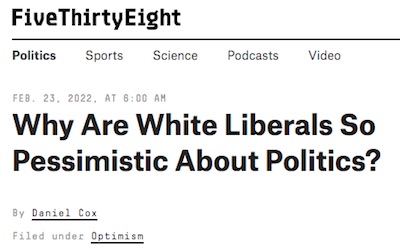 And so, an article by Daniel Cox on why white
liberals like me are pessimistic and pissed off. [2] At
first blush, I don’t quite see why anbody needs this article, because isn’t it obvious?
But then, I’m a white liberal, so perhaps it’s a case of fish not perceiving the water in
which they swim.
And so, an article by Daniel Cox on why white
liberals like me are pessimistic and pissed off. [2] At
first blush, I don’t quite see why anbody needs this article, because isn’t it obvious?
But then, I’m a white liberal, so perhaps it’s a case of fish not perceiving the water in
which they swim.
Interestingly, Cox runs the American Enterprise Institute’s Survey Center on American Life. Now, the AEI is such a far-right nuthouse that I would never even think to read it. So if they have something credible to say that passes muster with my brother and sister statisticians at FiveThirtyEight… maybe I should pay attention. Thus here we are.
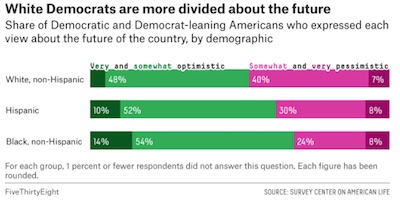 His first Deep Thought is
that only half of Americans are optimistic. Given the general shape of the world as it
is, this is like saying only half of Americans are even vaguely rational: the real
question is why the optimists are so delusional?
His first Deep Thought is
that only half of Americans are optimistic. Given the general shape of the world as it
is, this is like saying only half of Americans are even vaguely rational: the real
question is why the optimists are so delusional?
Now, he doesn’t publish his data, so we can’t check for ourselves, but: looking at that barplot above, do you think the difference is statistically significant? It seems like a medium-sized effect at best, and the lack of a $p$-value raises my hackles a bit. Still… this is FiveThirtyEight, which is full of people like me who probably asked that question and wouldn’t publish it without a positive answer. I hope.
Oddly, he asserts American society has moved to the left in recent decades. That strikes me as straight-up right-wing delusion: we’re far more conservative than we used to be, and downright crazy about it. True, more voters identify with liberal policies. But Republicans have manipulated unrepresentative features of our government (gerrymandering, voter suppression, unrepresentative Senate, packed Supreme Court) to castrate elections and perpetuate their minority rule. Americans may be more liberal, but American government is sliding into fascism. But then, this is the AEI we’re listening to, so it makes sense he would assert that the country is ‘more liberal.’
Like his fellow conservative David Brooks, he says he thinks liberals aren’t religious enough or engaged in civic groups enough, like conservatives. Pfeh.
His next critique is that liberals consume more political media, and that’s making us depressed, pessimistic, and anxious. Which is just… okay, pretty fair point there. He feels this acts on liberals in a way that “warps our perception of the world”. Which is just… the sort of mulish name-calling one expects from conservatives, though it’s a surprise to find it in FiveThirtyEight.
But what’s the solution? Ignorance of politics sounds like a suicidal course. A packed Supreme Court, an unrepresentative Senate, gerrymandering, voter suppression laws, and proudly ignorant loudmouths wherever you look… this things do not inspire confidence for democracy.
I came away from this one disappointed: not much insight to be gained here, and precious little data to back up the promising title.
Reason 3: Red COVID
David Leonhardt at the New York Times continues his series, which we’ve previously cited, on the ‘Red COVID’ phenomenon of lower vaccination rates and higher deaths in Republican areas. [3][4][5]
Last week there was a sobering update on both the total deaths by political affiliation in the US, as well as trailing 30 day death rates:
- The first plot shows cumulative death rates per 100,000, stratified by county % of votes for
Trump.
- There was an initial blue wave in early 2020, as the coastal Democratic cities were hit. They have more contact with the outside world than the decidedly insular, borderline xenophobic cities of the interior (and their rural environs), so it makes sense the pandemic would hit the blue coastal cities first.
- Then the coastal cities got a grip, with masking, social distancing, and eventually vaccinating. The red areas did much less of that, and paid with their lives.
- The bottom plot shows the same sort of information, this time as a death rate per
100,000. (Basically the first plot is the time integral of this one.)
- We see the same inital blue wave as the pandemic hit the coastal Democratic cities.
- We then see the same, depressing cycle of waves in Republican areas where people refuse to mask, to distance, or to vaccinate. They cannot, however, refuse to die.
Schadenfreude pie is a shameful taste to acquire, but it feels as though the world is forcing this upon the survivors.
Reason 4: Republican vaccine defiance
Charles Gaba, the very persistent data journalist behind ACASignups, has updated his plot of vaccination rates versus Trump voting, which we’ve previously cited multiple times. This time, he’s constructded an animation showing just how rapidly things got worse in the red counties over a full year since the vaccines first became available. [6]
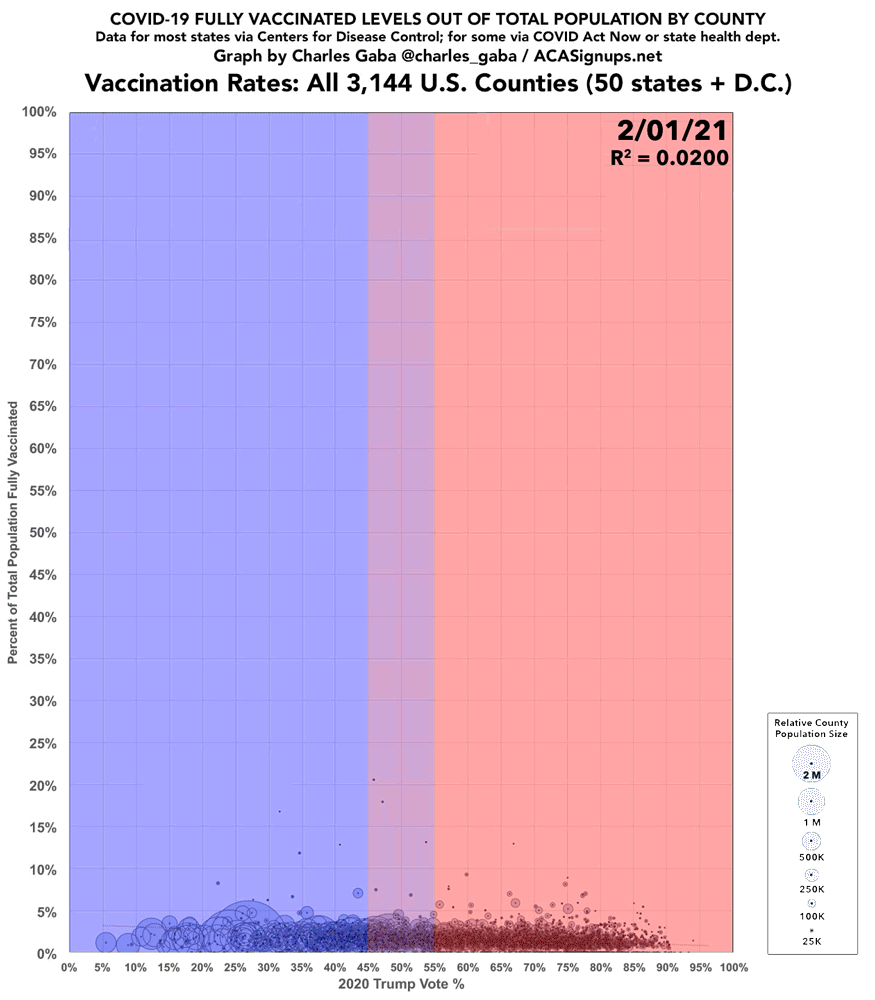
The most interesting thing to me about this animation is something Gaba also is at pains to point out:
As I’ve been noting for awhile now, the most telling thing about this is how there was virtually no partisan gap in the first couple of months (February & March), when only seniors, healthcare workers and certain immunocompromised & other select groups were eligible to get vaccinated.
The early days of vaccination were desperate times, and those most at risk reached out to get shots ASAP. (Your humble Weekend Editor and Editrix, as junior senior citizens, were happily among them.) But as soon as we dipped into the general population, the knuckleheads began to scream against vaccinations, for reasons ranging from superstition to insanity. As Derek Lowe, the formidable med-chem blogger at In the Pipeline at Science Translational Medicine put it:
The vaccines, I am informed by passionate people with degrees from Twitter State University, are making the coronavirus strains worse, turning vaccinated people into destructive super-spreaders, making them far more likely to die from the next variant, giving them ADE, making them sterile, giving them heart attacks, giving them cancer, destroying their immune systems, giving them HIV outright, rearranging their DNA, rearranging it so that their DNA is now covered under evil Pharma patents and they are now thus owned by drug companies, rearranging it so that they are now technically another species entirely, targeting this particular ethnic group over here, deliberately sparing this particular ethnic group over there, filling everyone’s bodies full of tracking devices, filling them full of alien nanotech micro-bots, filling them full of 5G antennas, filling them full of aborted fetal cells, filling them full of Satanic messages and portraits of Bill Gates and trial memberships for Amazon Prime and God knows what else.
It’s hard not to be gloomy about the future in the face of furious ignorance from conservatives like that. And it’s not like they’re a minority; since Reagan, the Republican party has migrated far rightward and crazy-ward until now it looks like they’re almost all like that.
Should you have the grave misfortune to find yourself inadvertently Republican, you have my sympathy. And my advice: get out of the crazy party.
Reason 5: Vaccine miracles, disinfromation curses
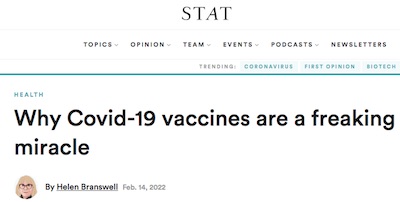 The redoubtable Helen Branswell, writing at STAT News, catalogs some of the ways in which
the COVID-19 vaccines have been exactly what we mean when we say
“miraculous” [7]:
The redoubtable Helen Branswell, writing at STAT News, catalogs some of the ways in which
the COVID-19 vaccines have been exactly what we mean when we say
“miraculous” [7]:
- Record breaking efficacy at 90% and above, developed with record shattering speed. Just go back and read some of the early posts on this crummy little blog that nobody reads (CLBTNR), and you’ll see me gushing about that too (here, here, here, here, here, here,). Well done, vaccine makers.
- Also, in a bit under 1 year, we’ve managed to vaccinate 55% of the entire human species! Yes: that’s too little, we haven’t done it equitably, we’ve done it too slowly to prevent variants, and so on. We’ll eventually do the right thing there (after, in the alleged words of Winston Churchill, “exhausting all possible alternatives”).
- Vaccination has saved millions of lives, just in the US; many more world-wide.
- We had a solid foundation in mRNA research, just poised to bear fruit at the exact moment it was needed. “Miracle” is, if anything, an understatement here.
- Branswell closes by quoting Ana Durbin, director of the Center for Immunization Research
at Johns Hopkins:
We’ve demonstrated that, given the resources, you can develop, evaluate, produce, and distribute a totally novel vaccine to hundreds of millions, if not billions of people, given a huge effort and extensive financial resources.
So why aren’t we all celebrating in the streets, with smiles all around? Good job, right?
 Well… sort of.
Well… sort of.
As the Washington Post editorial board pointed out yesterday [8], while we have miraculous vaccines, we labor under the self-inflicted curse of disinformation. (And “self-inflicted wounds are the slowest to heal”, as I hate to realize but always say anyway.) People just cannot stop saying stupid stuff about vaccines even when it costs lives. If you were to tell me the anti-vax disinformation campaign were found to be an act of terrorism by a hostile foreign power, I would of course want to see evidence, but I would be favorably disposed toward this explanation.
They start by quoting Helen Branswell (“freaking miracle”). But then:
- 5% of people think the vaccines contain microchips (but see Dr. Pip previously in this CLBTNR),
- 7% thought the vaccines use aborted fetal cells,
- 8% thought the vaccines could alter human DNA,
- 10% thought the vaccines could cause infertility…
…and 46% were “uncertain” about at least one of those 4 lies.
On the Republican propaganda channel Fox News, Tucker Carlson apparently compared vaccine mandates to the Nazi medical experiment/torture acts of Nazi Germany, on Jan 21, according to the WaPo (op. cit.). Somehow, Republicans trust that more than they trust vaccination!
Hence… a gloomy outlook here at Chez Weekend. We cannot long survive with that sort of disinformation sewage pumped at high pressure into the minds of half of US citizens.
Reason 6: Racist violence from police
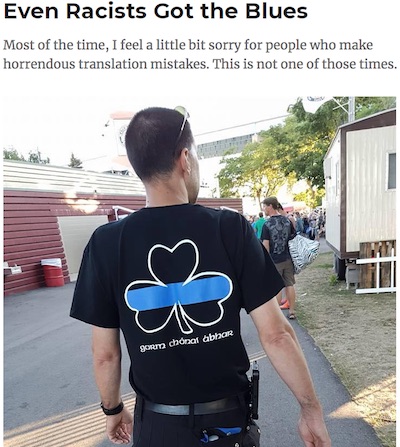 Look, the US is a racist country. Just get over it. Then set about fixing it.
Look, the US is a racist country. Just get over it. Then set about fixing it.
Unfortunately, in the meantime, we have to deal with our police forces as they currently exist. They have a regrettable tendency to be right-wing white supermacists, prone to violence since they view themselves as an occupying army. The number of pointless beatings and murders of Black Americans is distressing, of course, but nothing new. It’s just that we now have video on our phones so we capture it. That’s why cops so doggedly resist the right of the public to video them while on duty: it makes it much harder to cover up later.
With their hysterical opposition to the Black Lives Matter movement, cops sometimes like to counter that “Blue Lives Matter”, meaning they think they’re the real victims here. As a great many of them, for largely inscrutable reasons, also hew to a few bits of Irish culture, it was inevitable that they would try to translate that into Irish Gaelic. An example of this “wit” is shown on the back of the shirt worn by this poor unfortunate.
The Geeky Gaeilgeoir goes through why everything about this is wrong, both morally and linguistically. [9] In an attempt to translate “Blue Lives Matter” into Irish, mistakes were made in the overall syntax, in every single word, and in overall idiomatic meaning, with hilarious result:
- The words are not even vaguely in the Gaelic order, which is VSO: verb, subject, then object. Adjectives go after nouns. (Your humble Weekend Editor, while innocent of Irish Gaelic, once knew a little Scottish Gaelic.) So you should be shooting for something like: “[are important] [people] [blue]”.
- To say something “is important” is a whole different phrase; our dumb cop here chose the word for the noun matter, as in material objects like dirt, water, and air.
- Instead of the word “lives” (with a long I), he chose the verb “lives” (with a short I) as in “is alive”. The Irish Gaelic equivalent would have been something like the word for “people”.
- Well, gorm does mean blue. But when referring to people, colors usually mean hair color, not skin color! Dubh would mean a black-haired person, not a racial indication. So this use of gorm could mean people with blue hair, except… “blue” an indirect and polite way in modern Irish to refer to Blacks.
So even if you spot the racist jerk a few points for grammar, word order, and incompetent use of the dictionary… he ended up almost saying something idiomatically close to “Black Lives Matter”!
I can’t make up stuff this weird. And I’m good at weird.
The fact that I have to reach this far to find something funny is symptomatic of just how dark the times are. We’re being taken down by people who are not just violently authoritarian racists, but who are this stupid, too.
And we haven’t even started in on climate change, which may kill billions in the generations to come. If you’re a boomer (like your humble Weekend Editor) and are puzzled as to why the millennials all seem mad at you, this is why. In their place, I’d be mad at us too. (I vs Us?? Counterfactual subjunctives and pronominal reference don’t play well together in English! Do they do any better in any other languages?)
The Good News: 6 Reasons to Hope
Many of the Davidic Psalms in the Hebrew Bible start out as lamentations. At a crucial point in the middle, they pivot to thanksgiving for anticipated forgiveness and redemption. So it is here, or at least we shall attempt to be so.
 Actor George Takei seems to be a kind and decent fellow. Once when appointed to a transportation
board in California (more or less based on celebrity), he actually went out and learned
about transportation issues, so he could be competent. He’s more than just an actor,
he’s a pretty smart, capable, and responsible guy.
Actor George Takei seems to be a kind and decent fellow. Once when appointed to a transportation
board in California (more or less based on celebrity), he actually went out and learned
about transportation issues, so he could be competent. He’s more than just an actor,
he’s a pretty smart, capable, and responsible guy.
He’s also old enough at age 84, and 3rd generation Japanese-American, to have been in one of the WWII internment camps during one of America’s xenophobic periods. KK Ottersen recently interviewed him about those memories (and his graphic novel on the subject) in the Washington Post.[10]
There are many aspects to the interview, both cruel and beautiful. One bit that particularly stuck with me was this one:
You know, my father said resilience is not all just teeth-gritting determination. It’s also the strength to find and see beauty in an ugly situation. To be able to find joy, make our joy, behind barbed wires and all these people wallowing in their misery.
So his father started baseball teams. And dance groups in the evening, with a record player in the mess hall. And they produced musicals. All of that, in a prison camp in their own country.
That’s resilience: the insistence on finding or creating bits of beauty amidst the misery.
Let us attempt resilience.
Reason 1: The COVID-19 Omicron wave is finally fading
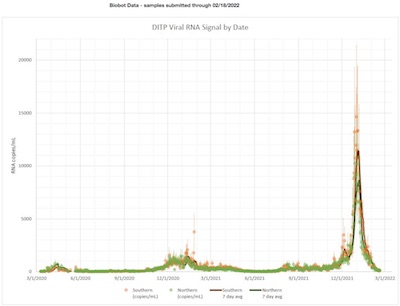 From the Massachusetts Water Resources Authority’s measurement of SARS-CoV2 mRNA in Boston
metro wastewater [11] comes evidence that the Omicron wave
is finally ending. As you can see from the plot, the wastewater levels of viral mRNA are
almost back down to baseline.
From the Massachusetts Water Resources Authority’s measurement of SARS-CoV2 mRNA in Boston
metro wastewater [11] comes evidence that the Omicron wave
is finally ending. As you can see from the plot, the wastewater levels of viral mRNA are
almost back down to baseline.
As we discovered in our last analysis of this data for the Omicron wave, cases follow this signal about 7 days later, and deaths about 19 days later. Roughly, we can expect that by about 2022-Mar-15, we can expect the COVID-19 death rate to decrease back to baseline.
Until another variant pops up, that will constitute at least a temporary reprieve for the vaccinated. (The unvaccinated, of course, might as well paint targets on their backs and carry signs saying “Infect me!”)
So while the pandemic is definitely not over in Boston (or in the US), we might look forward to a reprieve in about 3 weeks.
That will be… welcome.
Reason 2: mRNA HIV vaccine trials
Remember in 2020-Nov when we predicted this whole mRNA business would revolutionize vaccine research & development? Remember back in 2021-Aug when we confirmed that picture with the hints that an HIV vaccine trial would soon start from Moderna?
No? That’s ok, we didn’t really remember either, and had to look it up.

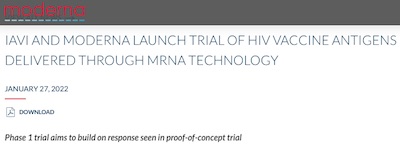
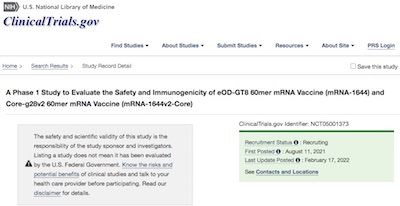 But it’s true: the HIV mRNA vaccine trial has finally started dosing people in Phase I,
according to press releases from the International AIDS Vaccine
Institute [12] and Moderna. [13]
The clinical trial is NCT05001373, also known as IAVI G002 [14], available for your perusal at ClincalTrials.gov.
But it’s true: the HIV mRNA vaccine trial has finally started dosing people in Phase I,
according to press releases from the International AIDS Vaccine
Institute [12] and Moderna. [13]
The clinical trial is NCT05001373, also known as IAVI G002 [14], available for your perusal at ClincalTrials.gov.
It uses a 60-mer of mRNA, and in some arms assesses a boosting immunogen (usually called an adjuvant? or maybe someting else…) to induce maturation of memory B cells and the production of broadly neutralizing antibodies (bnAbs). Given how fast the HIV virus can mutate, the ability to retarget the mRNA in almost real time will probably prove important.
It looks like a fairly complex design for a Phase I, with various arms getting the origianl vaccine, the original vaccine plus the boosting immunogen/adjuvant, and some getting just the boost immunogen/adjuvant.
We wish them luck! It’s time for AIDS to go.
Reason 3: Poking a hibernating bear with a cancer immunotherapy stick
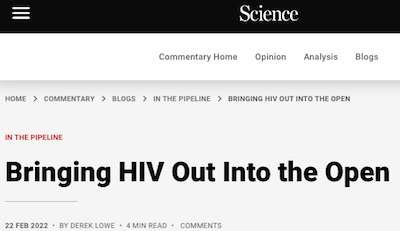
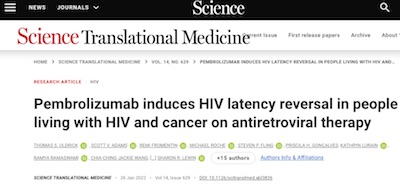 Med-chemist and blogger Derek Lowe at In the Pipeline has some fascinating
news [15]
of a paper [16] on the
interaction of cancer PD-1 therapies and latent/hidden HIV virus in people taking
maintenance therapy for AIDS.
Med-chemist and blogger Derek Lowe at In the Pipeline has some fascinating
news [15]
of a paper [16] on the
interaction of cancer PD-1 therapies and latent/hidden HIV virus in people taking
maintenance therapy for AIDS.
The paper is, alas, paywalled; but Lowe’s description is fascinating. First, some background:
- PD-1 (“programmable death receptor 1”) is a gene now at the focus of many innovative
immunotherapies in cancer.
- It basically calms down T cells, stopping them from killing things.
- Some tumors take advantage of this by expressing PD-L1 on their surfaces, which then binds to PD-1 and tells T cells not to kill the tumor.
- So of course there are now multiple therapies for blocking PD-1 so T cells can see tumors properly and kill them.
- There is also a lot of interest in combination therapies, to discover what other drugs pair well with PD-1 inhibitors.
- AIDS is a complicated disease caused by the complicated virus HIV.
- When HIV is active, it pretty much kills off the immune system, including the T cells.
- Modern therapies can combat active HIV pretty well, but HIV is sneaky: it can hide somewhere (not completely understood) and come back later when the drugs are withdrawn.
- This means people have to stay on anti-HIV drugs for the rest of their lives.
The paper adds the interesting discovery: some forms of PD-1 cancer therapies, for reasons not really understood, tease out the latent HIV virus and make it come out to go on the attack against the immune system.
Lowe compares this to poking a hibernating bear with a stick: if all you’ve got is a stick, this is a bad idea. But if you also have a shotgun loaded for bear, and for some reason you need to kill a bear, then this can work.
And so it is here: we have therapies that work against active HIV, and now we have a PD-1 therapy that (sometimes) turns latent HIV into active HIV, out where we can fight it.
This discovery hinged on having patients who have both AIDS and a PD-1-appropriate cancer simultaneously, which is bad luck squared! Let’s all be thankful for these afflicted folk who participated in a clinical trial and may have led to a life-saving discovery.
If this works out, adding a PD-1 inhibitor to the AIDS cocktail of drugs would force the remaining virus out in the open where it can be attacked… and possibly cure the disease, at least up to the amount of viral genes retrotranscribed into the genome.
So that’s 2 good bits on AIDS: prevention and treatment.
Reason 4: White paint? Yes, white paint. VERY white paint.



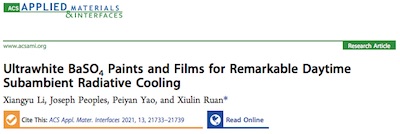 What’s so interesting about white paint?
What’s so interesting about white paint?
Well, if it’s really white, it reflects a lot of solar energy. For example, if you could paint roofs really, really white you could reflect a lot of sun back into space, and even make a meaningful impact on climate change.
Can we do that? Apparently we can, now.
I originally stumbled across this story via a PBS NewsHour report [17], which led to a Purdue Univesity press release [18], which pointed at a patent [19], and finally led to the paper (paywalled, but somebody sent me a copy) [20].
Basically Ruan and colleagues at Purdue have discovered a very highly reflective white paint, based on BaSO4 with a distribution of particle sizes tuned to the blackbody radiation of the sun. It reflects most solar energy, and what it emits in infrared it emits in the sky window that gets out through the atmosphere without being reflected back to earth.
 The result is that it stays about 4.5°C below ambient temperature and achieves a
cooling power of about 117 W/m2, as shown here in their Figure 3 (click to embiggen).
That’s enough, if painted on the roof of a building, to
take up a substantial portion of the air conditioning load. If many roofs in an area are
thus painted, the average temperature goes down. They calculate that 1% of the earth’s
surface being this relfective would be enough to stop global climate change.
The result is that it stays about 4.5°C below ambient temperature and achieves a
cooling power of about 117 W/m2, as shown here in their Figure 3 (click to embiggen).
That’s enough, if painted on the roof of a building, to
take up a substantial portion of the air conditioning load. If many roofs in an area are
thus painted, the average temperature goes down. They calculate that 1% of the earth’s
surface being this relfective would be enough to stop global climate change.
Barium sulfate is nontoxic (used in make-up and even internally in intestinal imaging), and its mining is more eco-friendly than the current white paint pigments.
This could be big. And it’s simple, so it can be done in the developing world, too.
Reason 5: Food production

 Plants are a genetic nightmare: huge genomes, unimaginably complex biochemistry, making
molecules the size of battleships… very different from animals, or fungi, or
bacteria, or archaea! So every time we try to monkey with their genome to increase food
or oil or fiber production, lots of stuff has to be consideered.
Plants are a genetic nightmare: huge genomes, unimaginably complex biochemistry, making
molecules the size of battleships… very different from animals, or fungi, or
bacteria, or archaea! So every time we try to monkey with their genome to increase food
or oil or fiber production, lots of stuff has to be consideered.
Derek Lowe, again at In the Pipeline, reports [21] a novel paper [22] (behind a regrettable paywall) on messing with RNA methylation in certain food plants.
- N6-methyladenosine is one of many epigenetic markers (basically a Sharpie making marks on the genome to note which genes should be on or off in each tissue) found almost everywhere.
- Humans have a gene called FTO that demethylates N6-methyladenosine, in a way that plants do not.
- So what happens if you put the human FTO gene in potatoes and rice? Interesting stuff, that’s what!
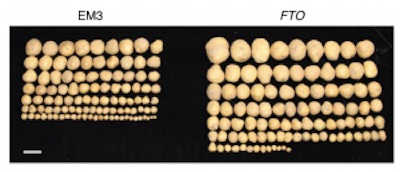 Here are some potatoes grown with and without the extra FTO gene. See howmuch larger they
are on the right? The result was that crop yields in rice and potatoes went up by 50%
with the insertion of FTO. In rice, grain size remained constant as did overall plant
size; they just produced a lot more grains of rice. In the potatoes above, the overall
number of potatoes is about the same, but the overall weight of potatoes skyrocketed. In
both potatoes and rice, nutritional quality (starch, protein, total carbohydrate, vitamin
C content) remained about the same.
Here are some potatoes grown with and without the extra FTO gene. See howmuch larger they
are on the right? The result was that crop yields in rice and potatoes went up by 50%
with the insertion of FTO. In rice, grain size remained constant as did overall plant
size; they just produced a lot more grains of rice. In the potatoes above, the overall
number of potatoes is about the same, but the overall weight of potatoes skyrocketed. In
both potatoes and rice, nutritional quality (starch, protein, total carbohydrate, vitamin
C content) remained about the same.
Basically FTO made deeper and more extensive roots, and boosted photosynthetic efficiency “by a startling 36%”, in Lowe’s words. Transpiration from leaves (basically plant breathing) was up 78%, and drought tolerance was also improved. These are exactly the traits we want to see in a world of hostile climate change.
Of course there will be hysterical, superstitious resistance to what will probably be called “Frankenstein potatoes”. But it’s better than letting the world starve. (Of course, I thought vaccination was better than letting people die. We know how that worked out.)
Reason 6: Near(er) term fusion

We’ve written about this previously, but it bears repeating. Fusion power has been “20 years in the future” for the last 50 years, by most scientist’s reckoning. There’s a bit of “boy who cried wolf” to fusion stories for that reason.
But… there’s been some real progress. Commonwealth Fusion Systems, here in the Weekend Fiefdom of New England, reported building a 20 Tesla superconducting magnet [23], which is A Big Deal. (I remember as an undergrad back in the 1970s being impressed with a pretty gnarly 1 Tesla magnet.)
They’re building a tokamak architecture they call ARC (“affordable, robust, compact”, but we really know it’s the ARC reactor built by Tony Stark, a.k.a. Iron Man and another MIT graduate like the CFS folks). Their prototype SPARC (“smallest possible ARC”) is being built now in Massachusetts, expected to produce commercially meaningful power by 2025.
This changes everything. Not only can we decarbonize our entire energy infrastructure and eliminate fossil fuels, but we can also:
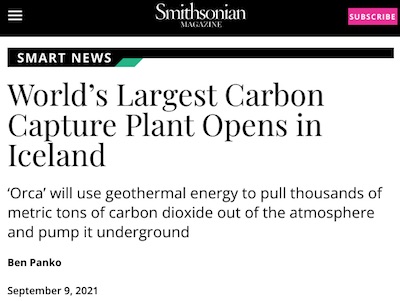
- Build desalinization plants to supply coastal cities with water. No longer will LA use most of the water in various rivers, contributing to the desertification of the southwest. The impact on the developing world could be life-saving.
- Build localized power with vertical farming technology, so food production can happen at scale, almost anywhere.
- Build steel minimills near where steel is needed or near transportation nexi; they no longer have to be sited according to power availability.
- Build carbon sequestration plants all over, using fusion power to capture and store CO2 underground in more stable forms, like the Orca plant in Iceland. [24] Orca is currently geothermal, which works in Iceland but not elsewhere. Cheap fusion power means we could do that everywhere.
… and a ton of other applications dependent on compact, localized, clean power.
The Weekend Conclusion: 12 Reasons to be Confused
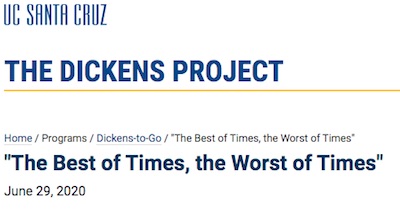 Best let the best author
have the (nearly) last word:
Best let the best author
have the (nearly) last word:
It was the best of times, it was the worst of times, it was the age of wisdom, it was the age of foolishness, it was the epoch of belief, it was the epoch of incredulity, it was the season of light, it was the season of darkness, it was the spring of hope, it was the winter of despair. — Charles Dickens, A Tale of Two Cities
So shall we go against our natural grain and be optimists? Or shall we be pessimists and depressed forever? It’s a difficult choice for me.
I was recently impressed by an essay of Jason Crawford at Less Wrong [25] on the subject of what exactly optimism and pessimism mean. He distinguishes:
- Descriptive optimisim: Believing that good things will naturally happen. This is the view of the maddening Professor Pangloss: “this is the best of all possible worlds.” I’m normally a pretty peaceful guy, but that sort of thing makes me want to punch Professor Pangloss. Good thing he’s a fictional character, no?
- Prescriptive optimism: A belief that we can and should do all that we can to make better outcomes, no matter the current state of the world. To match Professor Pangloss with a dueling adage: “we work to make this world much, much better.”
Descriptive optimists make me want to punch the delusional, a desire which I work to suppress. Prescriptive optimists make me want to ask what the work is that needs to be done, and where I can pitch in.
In fancier language: Romain Rollard, French writer & Nobel Laureate, reviewing Raymond Lefebvre’s The Sacrifice of Abraham (quoted by DJ Fisher: [26]), on being an optimist without hope:
this intimate alliance – which for me makes the true man – of pessimism of the intelligence, which penetrates every illusion, and optimism of the will. It is this natural bravery that is the flower of a good people, which “does not need to hope to undertake and to succeed to persevere,” but which lives in struggle over and above suffering, doubt, and the blasts of nothingness because his fiery life is the negation of death.
When simultaneously confronted with optimism and pessimism, my personal position is closer to that of one of my favorite authors, James Branch Cabell who thus satirizes Professor Pangloss:
The optimist proclaims that we live in the best of all possible worlds; and the pessimist fears this is true. — James Branch Cabell, The Silver Stallion, Book 4, “Coth at Purutsa”, Ch XXVI: The Realist in Defeat
Notes & References
1: D Brooks, “The Dark Century”, New York Times, 2022-Feb-17. ↩
2: D Cox, “Why are White Liberals So Pessimistic About Politics?”, FiveThirtyEight, 2022-Feb-23. ↩
3: D Leonhardt, “Red America’s Covid Problem”, New York Times, 2021-Jun-28. ↩
4: D Leonhardt, “Red Covid”, New York Times, 2021-Sep-27. ↩
5: D Leonhardt, “Red Covid, an Update”, New York Times, 2022-Feb-18. ↩
6: C Gaba, “Updated: A Full Year Of U.S. COVID Vaccinations By Partisan Lean…Animated”, ACA Signups, 2022-Feb-02. ↩
7: H Branswell, “Why Covid-19 vaccines are a freaking miracle”, STAT News, 2022-Feb-14. Happy Valentine’s Day, get vaccinated. ↩
8: WaPo Editorial Board, “Opinion: How many people died believing vaccine misinformation?”, Washington Post, 2022-Feb-22. ↩
9: A Nickel, “Even Racists Got the Blues”, The Geeky Gaeilgeoir, 2020-Jun-01. ↩
10: KK Ottersen, “George Takei: ‘I maintain that without optimism, we’ve already failed’”, Washington Post, 2022-Feb-15. ↩
11: Massachusetts Water Resources Authority, Biobot wastewater RNA data, retrieved 2022-Feb-23. ↩
12: K Youngdahl, “IAVI and Moderna launch trial of HIV vaccine antigens delivered through mRNA technology”, International AIDS Vaccine Institute Press Releases, 2022-Jan-27. ↩
13: C Hussey, “IAVI AND MODERNA LAUNCH TRIAL OF HIV VACCINE ANTIGENS DELIVERED THROUGH MRNA TECHNOLOGY”, Moderna Press Releases, 2022-Jan-27. ↩
14: International AIDS Vaccine Initiative, “NCT05001373: A Phase 1 Study to Evaluate the Safety and Immunogenicity of eOD-GT8 60mer mRNA Vaccine (mRNA-1644) and Core-g28v2 60mer mRNA Vaccine (mRNA-1644v2-Core)”, ClinicalTrials.gov, last updated 2022-Feb-17. ↩
15: D Lowe, “Bringing HIV Out Into the Open”, In the Pipeline blog at Science Translational Medicine, 2022-Feb-22. ↩
16: TS Uldrick, et al., “Pembrolizumab induces HIV latency reversal in people living with HIV and cancer on antiretroviral therapy”, Science Translational Medicine 14:629, 2022-Jan-26. DOI: 10.1126/scitranslmed.abl3836. ↩
17: J Yang & L Baldwin, “Can the world’s whitest paint save Earth?”, PBS NewsHour, 2021-Oct-18. ↩
18: K Wiles, “Purdue record for the whitest paint appears in latest edition of ‘Guinness World Records’”, Purdue University News, 2021-Q3. ↩
19: X Ruan, X Li, Z Huang, & JA Peoples, “1. WO2020072818 - METAL-FREE SOLAR-REFLECTIVE INFRARED-EMISSIVE PAINTS AND METHODS OF PRODUCING THE SAME”, PatentScope publication number WO/2020/072818, 2020-Sep-04. ↩
20: X Li, J Peoples, P Yao, & X Ruan, “Ultrawhite BaSO4 Paints and Films for Remarkable Daytime Subambient Radiative Cooling”, ACS Appl Matls & Interfaces 13, 21733-21739, 2021. DOI: 10.1021/acsami.1c02368. ↩
21: D Lowe, “One Lost Methyl Group = Huge Amounts of Food Production”, In the Pipeline blog at Science Translational Medicine, 2021-Jul-28. ↩
22: Q Yu, et al., “RNA demethylation increases the yield and biomass of rice and potato plants in field trials”, Nat Biotech 39, 1581-1588, 2021-Jul-22. DOI: 10.1038/s41587-021-00982-9. ↩
23: CFS Staff, “Commonwealth Fusion Systems creates viable path to commercial fusion power with world’s strongest magnet”, Commonwealth Fusion Systems press releases, 2021-Sep-08. ↩
24: B Panko, “World’s Largest Carbon Capture Plant Opens in Iceland”, Smithsonian Magazine, 2021-Sep-09. ↩
25: J Crawford, “Descriptive vs. Prescriptive Optimism”, Less Wrong blog, 2022-Jan-22. ↩
26: DJ Fisher, “Romain Rolland and the Politics of Intellectual Engagement”, Univ Calif Press, 1988. See header quote to “Conclusion”. Also here. The quote is from Rolland’s review of R Lefebvre’s The Sacrifice of Abraham. ↩

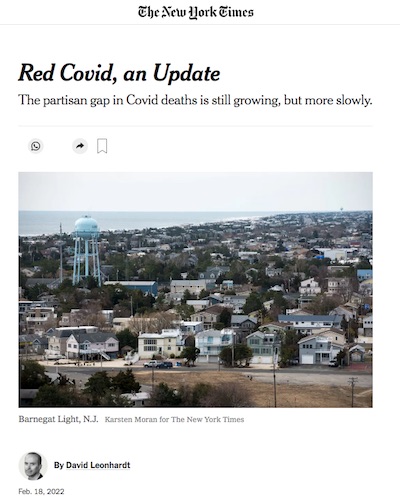
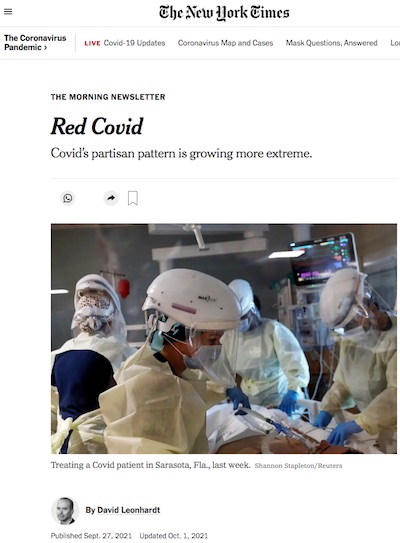
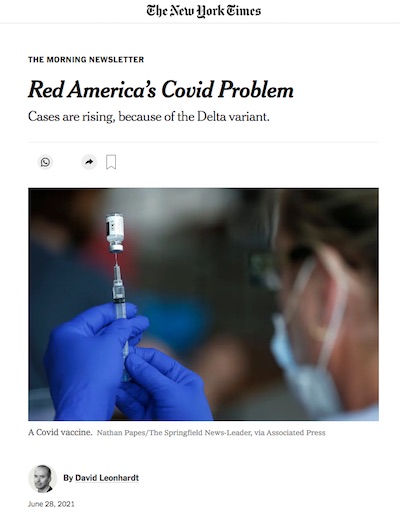
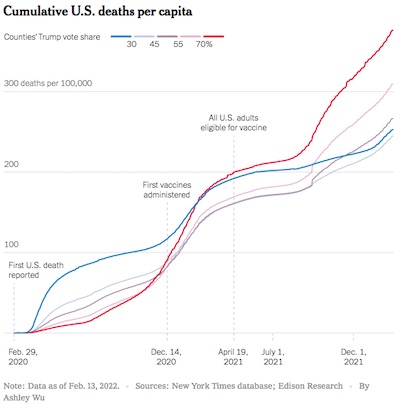
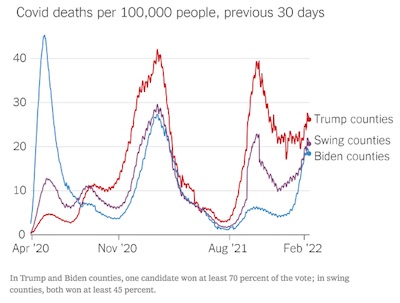
Gestae Commentaria
Comments for this post are closed pending repair of the comment system, but the Email/Twitter/Mastodon icons at page-top always work.